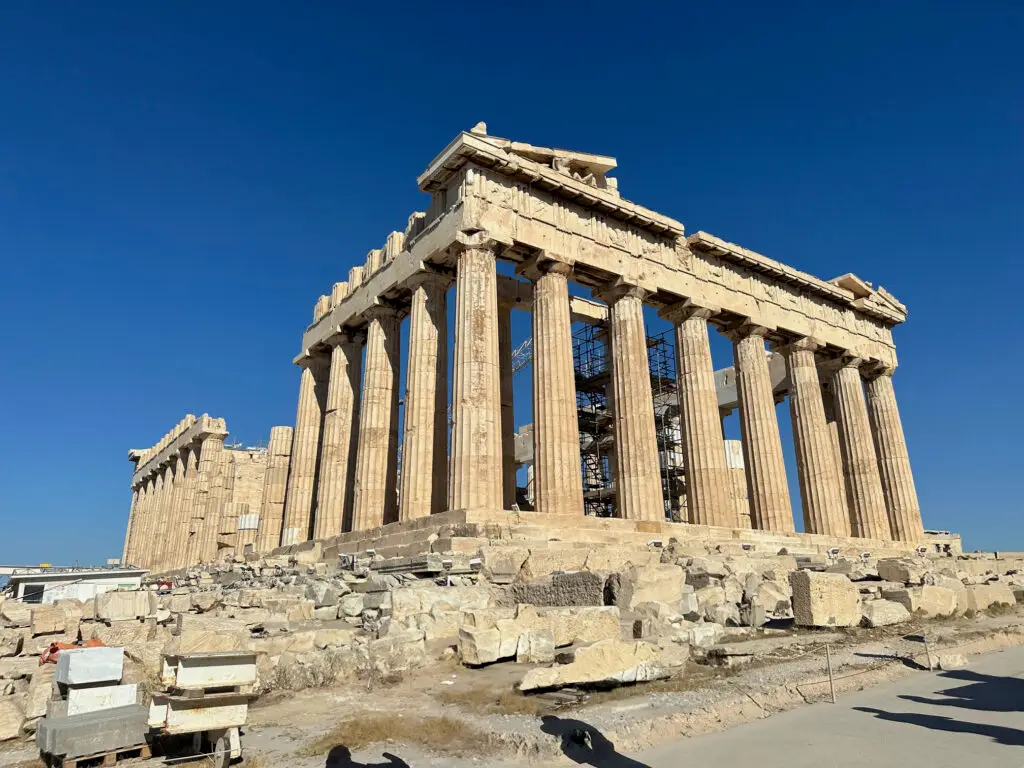
One Week in Greece Without the Tourist Price Tag: My Exact Itinerary
Dreaming of Greece but worried your budget won’t stretch past the Acropolis? I get it—I used to think the whitewashed villages, island sunsets, and seaside tavern dinners were only for honeymooners or Instagram influencers. But after spending a week hopping from Athens to the islands without draining my savings (or my points), I realized Greece doesn’t have to be expensive—it just has to be planned right.
This 7-day itinerary shows you exactly how to see the best of Greece—ancient ruins, island beaches, fresh seafood, and unforgettable sunsets—without overspending. Let’s make your dream trip happen, minus the sticker shock.
Flight Woes an ITA Airways Experience.
We flew from Venice to Rome, then from Rome to Greece. European airlines are notorious for delays, and this trip was no exception. Our original itinerary had us departing Venice at 6:20 A.M. and arriving in Athens at 11:15 A.M. Instead, our flight didn’t take off until midnight! Hello EU261 Claim!
ITA Airways
Despite the delays, I would still fly ITA again. Some of their 777s feature Recaro seats, which I find to be among the most comfortable. The European business class configuration is their standard setup—three seats with the middle one blocked. With all the delays and unexpected issues, lounge access and dedicated check-in lines were crucial in keeping the experience somewhat stress-free. While I wouldn’t pay extra just for the seat, the on-ground perks made it worth it. This flight cost 12,000 points per person, booked via Flying Blue using Citi points.
Arriving in Athens & Hyatt Perks
We landed at 3:30 A.M. the next day. Thankfully, Hyatt allows room charges for transportation, so I arranged a private transfer for 75€.Always charge services to your room when possible—this taxi ride alone earned me 850 points, worth anywhere from $17 to $40, depending on how I redeem them.

Grand Hyatt Athens
The Grand Hyatt Athens is an amazing value as a Category 3 property, averaging 12,000 points per night. From the rooftop pool, you get a stunning view of the Acropolis.
Dining & Lounge Experience
- The breakfast buffet spans two floors, offering a wide variety of high-quality options. The selection is comparable to Andaz Papagayo or Regency Maui.
- The club lounge was well-stocked with Mediterranean specialties—nuts, baklava, hummus, and a rotating selection of appetizers.
Exceptional Service & Exclusive Perks
The staff was incredibly accommodating. I even arranged a photographer for a rooftop photoshoot, and management was happy to grant us permission.
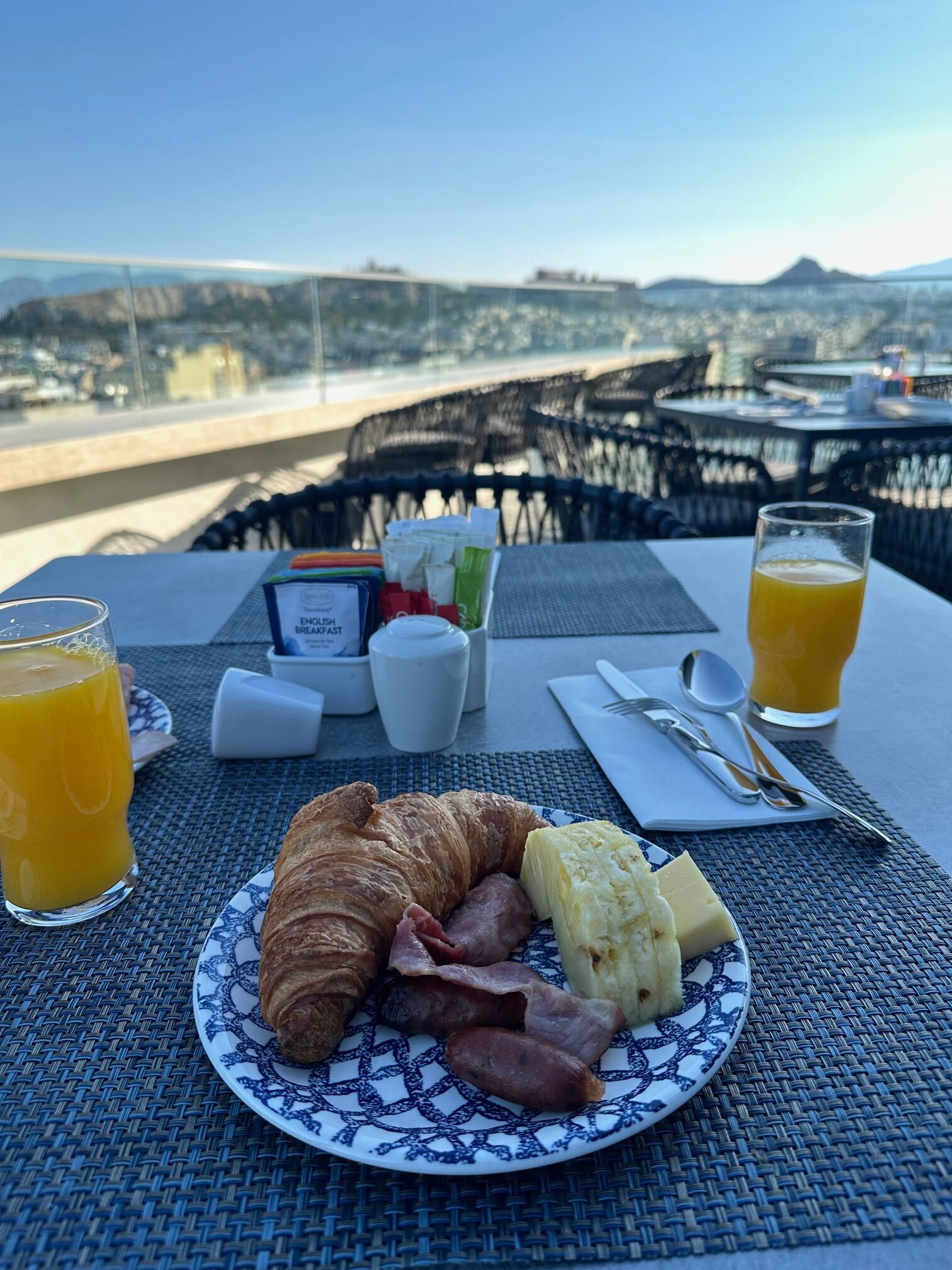 |  View from the Roof |
The hotel provides car seats for cabs but install them yourself—not once was it correctly installed when left to the drivers. Once you reach your destination, the cab driver is responsible for the car seat.
The hotel may be slightly understaffed at times. I saw large check-in lines (10–15 people) on occasion, but the staff worked efficiently to move guests through. The pool and bar areas had no staffing issues.
The Worst Elevators Ever
The elevator system was a disaster. Instead of buttons inside, you scan your keycard outside and select your floor. The system then assigns an elevator—A, B, C, or D—and you wait for it. Frustratingly, while you wait, you’ll see every other elevator come and go multiple times.
After three days, we gave up on them. Since we were on the third floor, we took the stairs instead. If we needed to go up to the pool or restaurant, we used the service elevator on the other side of the hotel.
Yet, for 12,000 points, this hotel is an absolute steal—especially with Globalist benefits.
A Relaxing Day at the Rooftop Pool
Our original plan was to visit the island of Poros, but I decided to call it off and spend the day at the hotel instead. I received a 50% refund for canceling the day of with Ferry Hopper.
We made the most of it, relaxing by the rooftop pool, which offers breathtaking views of Athens. The property has two pools—the ground-level pool is better suited for kids, while the rooftop pool is all about the views. It was the perfect way to unwind before diving into Athens’ historic sights.

Exploring the Acropolis: Booking, Protests & Entry Tips
Like anything in Europe, book your ticket in advance. I reserved an 8:45 A.M. entrance for the Parthenon, avoiding long wait times.
The hotel offers a shuttle to Plaka, from where it’s a short walk to the Acropolis hill. The hill isn’t steep, but the smooth granite road can be hazardous—if wet, it could turn into a slip-and-slide. Wear shoes with good grip.
Entering the Acropolis
Upon arrival, you’ll see two lines—one for ticket purchases and another for entry. Since I booked in advance, I skipped the ticket line. Walk past the first queue and make sure you’re in the line for security check, not the ticket office.
Unexpected Protest
On our visit, we walked through hundreds of protesters. Protests are common in Greece, and this one was against the Greek government allowing a private company to handle Parthenon ticket sales. Protesters alleged low wages and unfair benefits.
One employee even told me that the company manipulates employees hours to avoid paying certain benefits.
First Landmark: Temple of Athena Nike
Walking up the steps of the Acropolis is an experience in itself. If you look to the right upon entering, you’ll see the Temple of Athena Nike—a small but significant Ionic temple, dedicated to Athena and Nike, symbolizing victory and protection over Athens.
Temple of Athena Nike: A Symbol of Victory
The Temple of Athena Nike is dedicated to the goddesses Athena and Nike and was built between 427–424 BCE, during the height of the Athenian Empire.
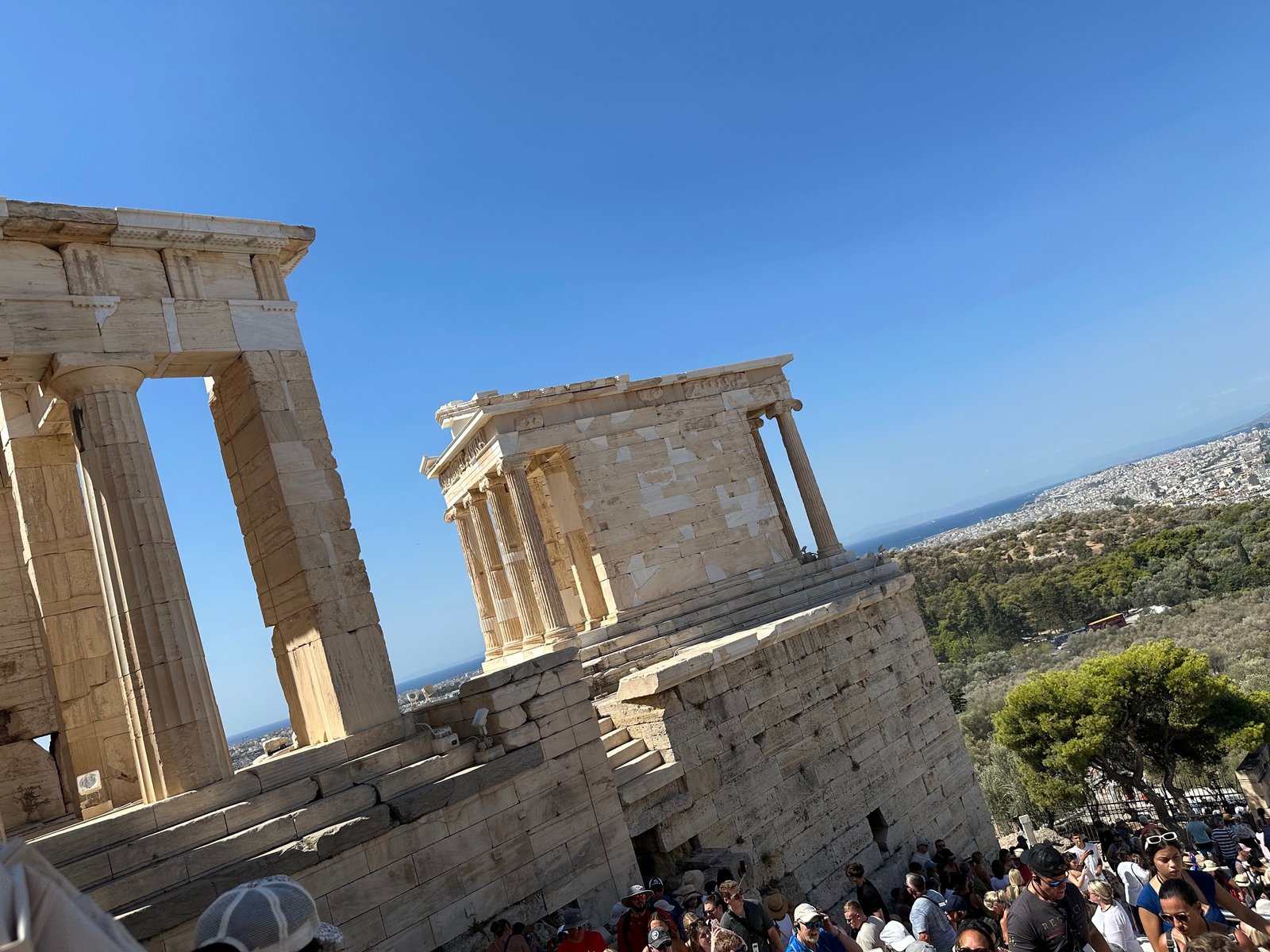
Standing here, you can imagine ancient Athenians honoring Nike, the goddess of victory, in hopes of continued triumph in battle.
Accessibility & Safety Tips
Use caution when walking up the stairs—they have been polished smooth over thousands of years by foot traffic. The Acropolis can be challenging for those with mobility issues due to:- Slick stone surfaces
- High winds
- Uneven terrain
For accessibility, there is a wheelchair elevator and some concrete pathways around the Parthenon. However, be aware that on our visit, the elevator, water fountains, and water vending machines were all out of order.
If you need these services, call ahead to confirm availability before your visit.
The Parthenon: A Monument Under Restoration
As you approach, you will notice scaffolding everywhere. The Parthenon is in a perpetual state of restoration, ensuring that this ancient wonder remains preserved for future generations.
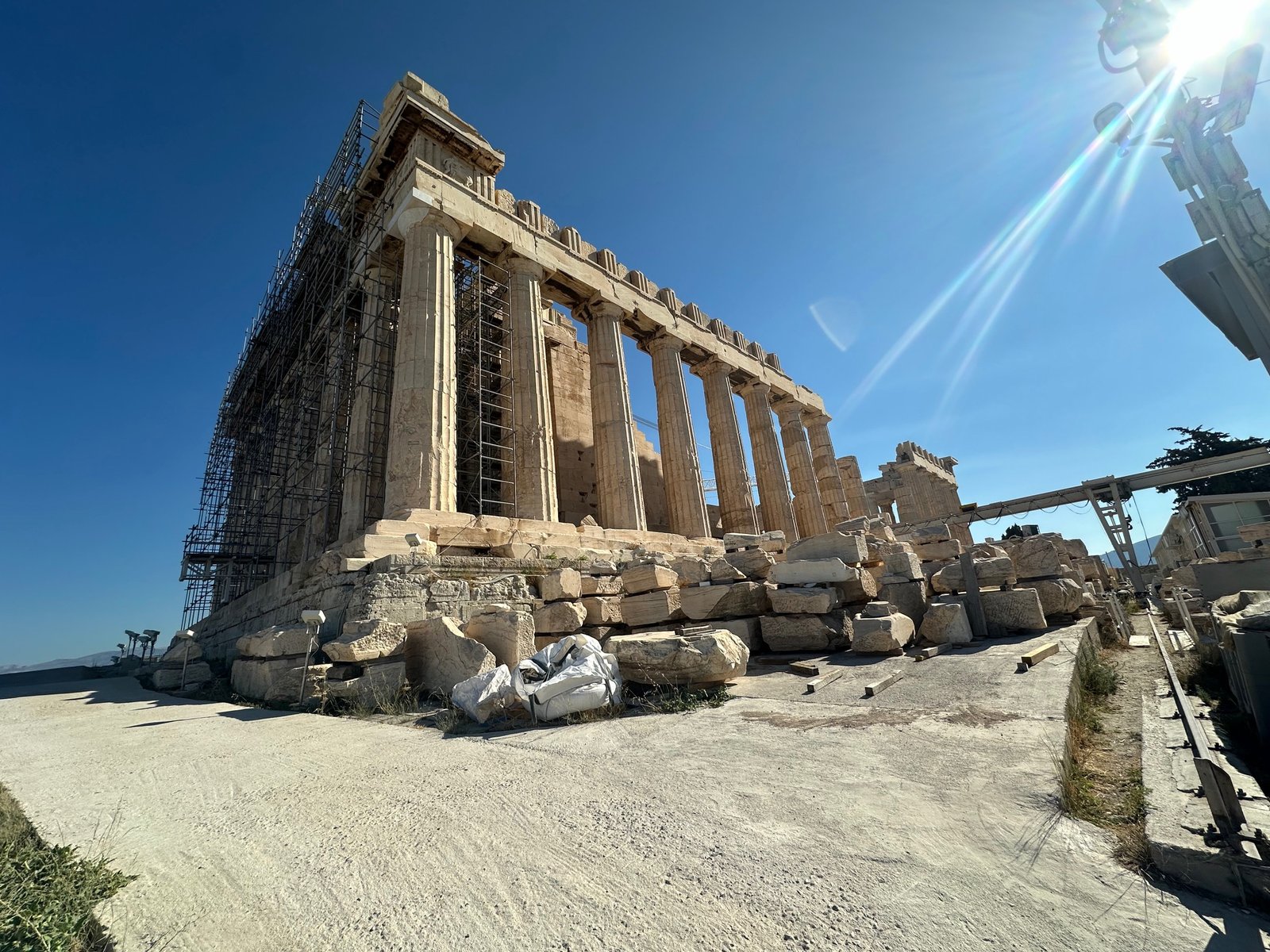 Front | 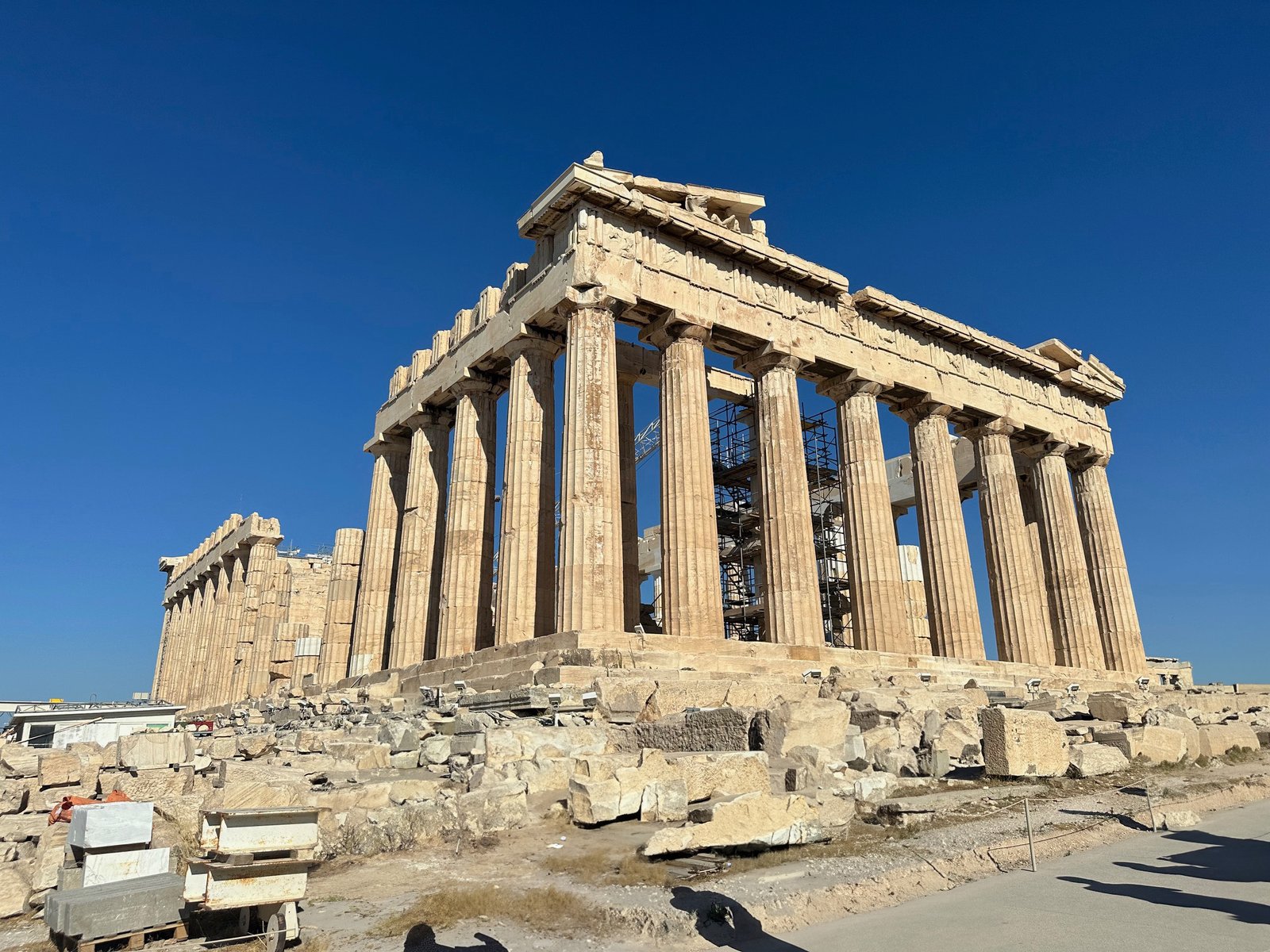 Back |
The 1687 Venetian Siege: The Parthenon’s Destruction
In 1687, during the Venetian siege of Athens, the Ottomans used the Parthenon as a gunpowder storage facility. Tragically, the Venetians accidentally struck the Parthenon with artillery fire, causing a massive explosion that destroyed much of the structure, including its roof and many sculptures. This single event transformed the Parthenon from a well-preserved temple into the ruins we see today.
Spectacular Views & The Walk to Plaka
There are merchants all the way down the hill. Most of them were peddling worthless trinkets, reminding me of 90s flea markets. You’ll find plenty of old items, but just because something is old doesn’t make it valuable.Many vendors were selling coins, claiming they were ancient artifacts, but be cautious—most of them are worthless or counterfeit.
Even if one happens to be authentic, remember that it is illegal to remove historical artifacts from Greece. Attempting to take one home could land you in jail.
Beyond the typical tourist traps, there were a few unique finds, but you have to hunt for them.
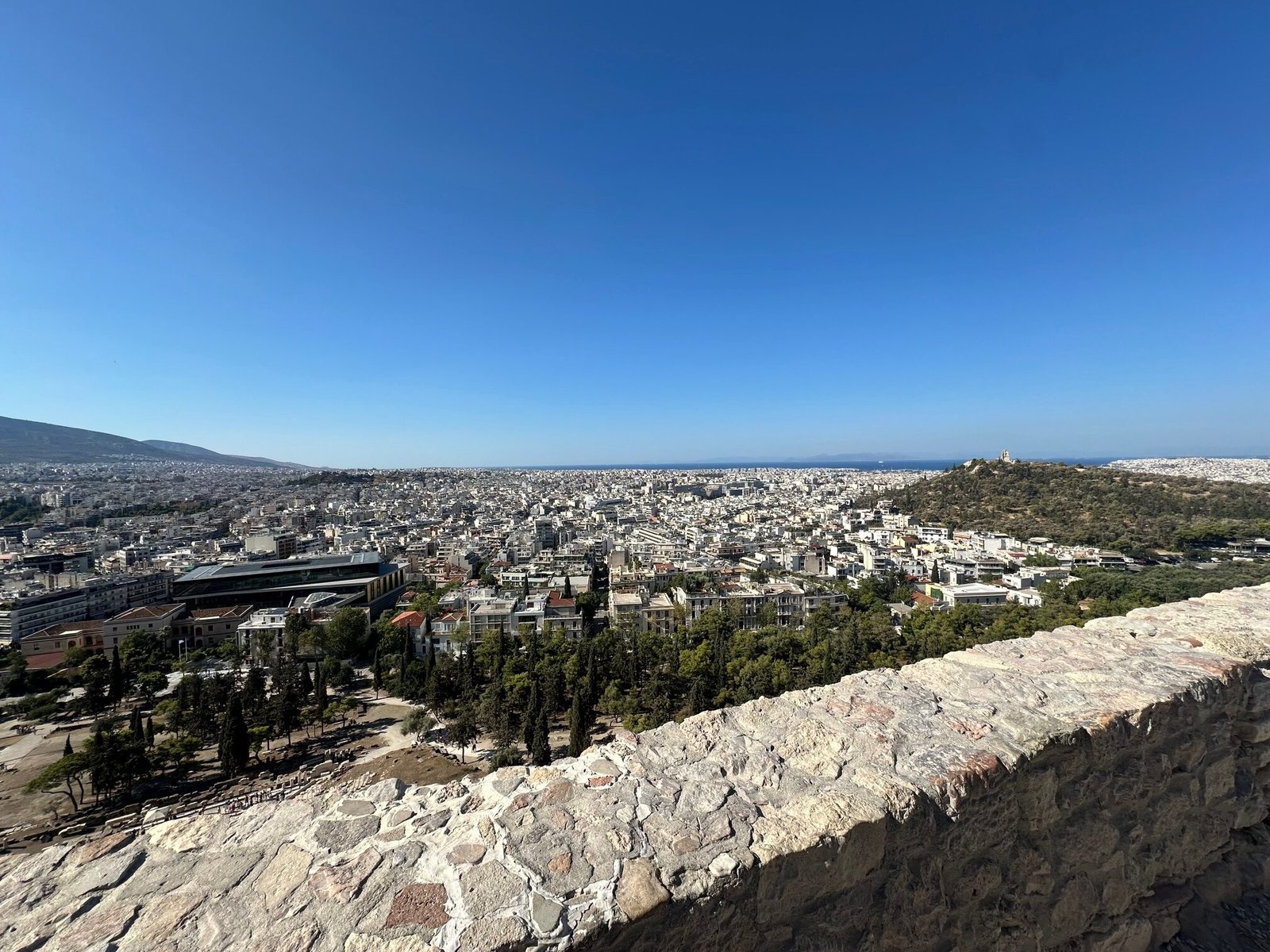
Views of the Mediterranean
Some local artists had their work on display, and while the quality varied, a few pieces stood out as truly one-of-a-kind souvenirs. If you’re looking for something authentic, skip the knockoff relics and seek out handmade art, ceramics, or textiles from local craftsmen.
Exploring Adrianou Street: Athens’ Souvenir & Art Hub
As we wandered, I did spot some local artwork, though it wasn’t quite my style. If you’re shopping for souvenirs, compare prices before you buy—the same item can vary significantly in cost from shop to shop.Hunting for Greek Marble & Art
I always like to bring home something unique, and this time, I was on the lookout for a piece of Greek marble and a painting. The best place to start? Adrianou Street, the main souvenir shopping area in Athens.
One of the standout finds was a hand-carved marble bust for 55€, while the lowest price I saw for the same bust elsewhere was 75€.
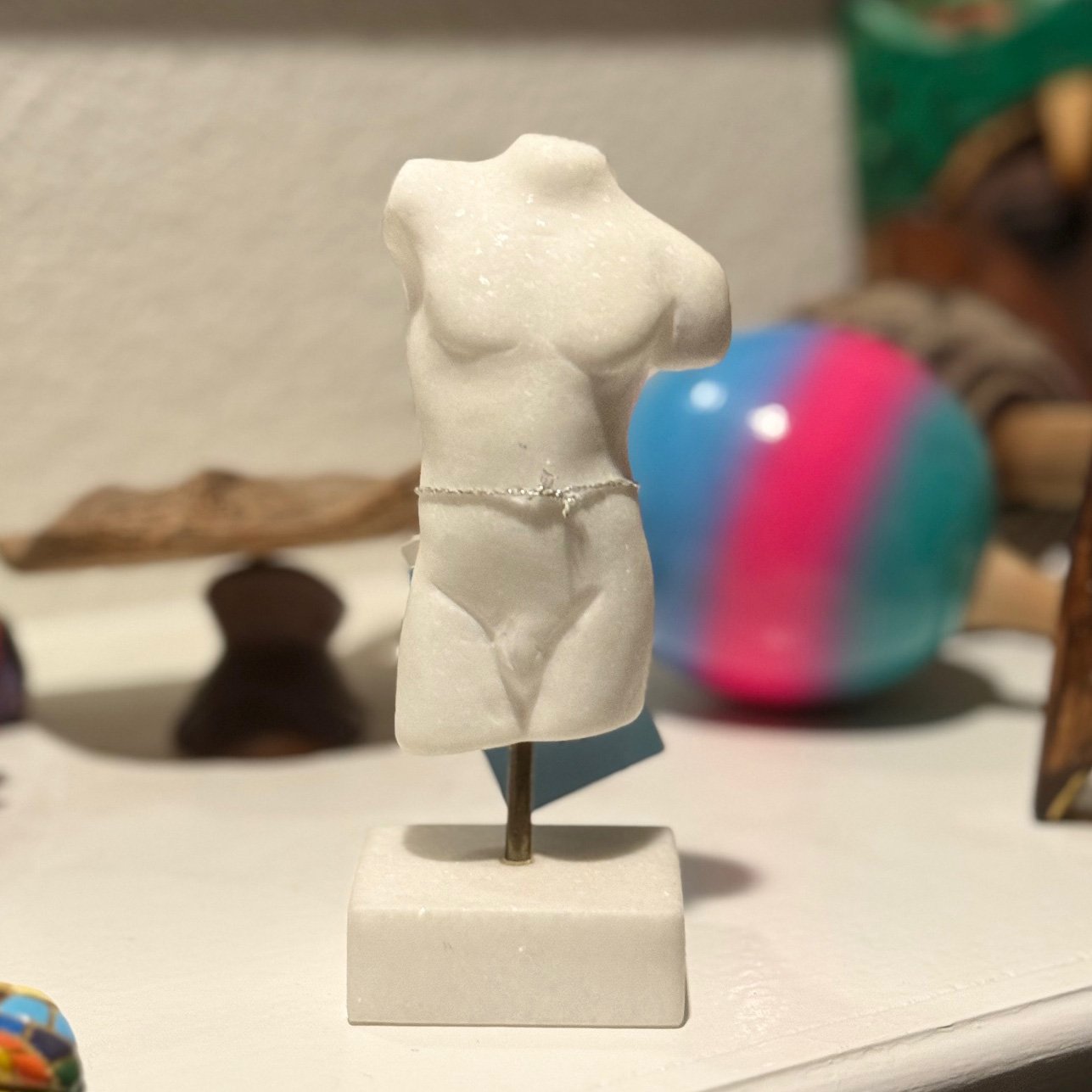
Athens’ Thriving Art Scene
Adrianou Street is lined with dozens of art galleries, most featuring works from students at the local art college. The quality varies widely, but I found the prices to be reasonable. I ended up purchasing a painting for 75€, and the gallery owner mentioned that the artist, was not a student, and was gaining recognition. A quick search confirmed she had been featured in local news for painting murals around the city
Art Prices
If you’re looking for art, prices range from 25€–300€ for student pieces, while works from established artists can run anywhere from 500€ to 20,000€. Whether you’re after a budget-friendly piece or a collector’s item, Athens has something for every art lover.
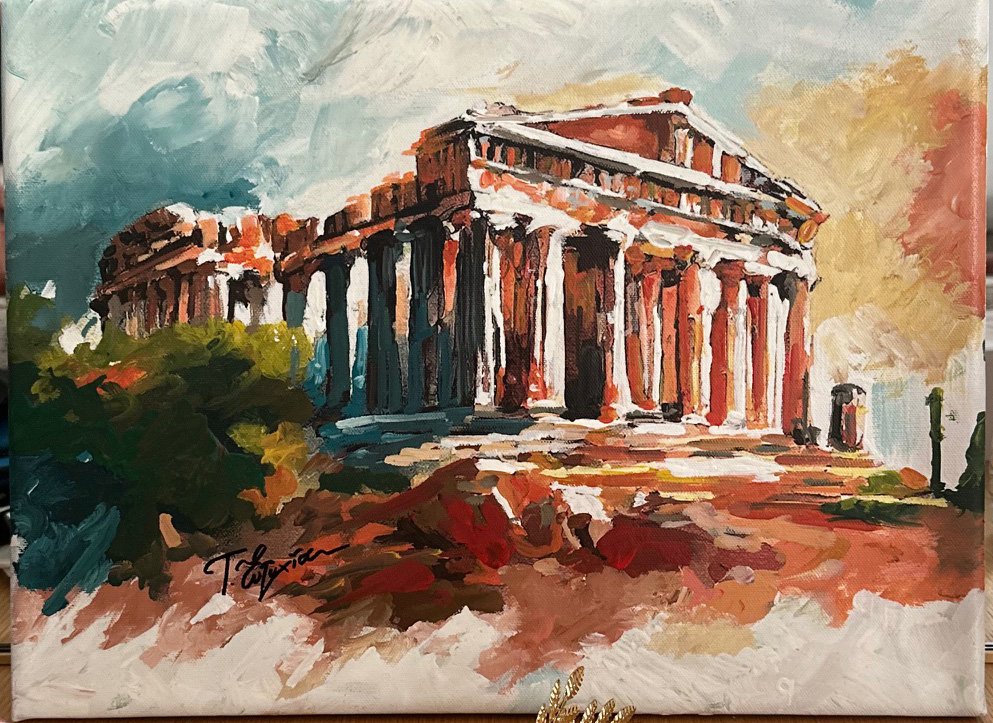
After finding what I wanted, we went to grab food. We ate at Athens Icon Ayora—a tourist spot but convenient. My daughter was set on a hotdog, and this was the only place I could find one.

Cab Tips in Athens
After eating, we took a cab back to the hotel. If you need a taxi in Athens, walk to a designated cab stand—don’t flag one down in a tourist area. I initially approached a cab dropping off passengers, but an American traveler warned me to confirm the price first because the driver was untrustworthy. Instead, we asked a local shop employee, who advised us to always use cab stands. Drivers queuing at these stands follow regulations and are less likely to overcharge tourists.
I had no issues with cab drivers in Athens when using official stands.
Affordable & Delicious Greek Food
My wife and our two-year-old arrived from Fort Worth at 8 PM. After their flight I figured they would be hungry. I headed down the street to a local Greek restaurant, Masína, for some takeaway. The food was incredibly affordable:
- Pita wraps – 4€ each
- Kabobs – 2.60€ each
- Full plates – 11–12€
I found that a pita and a kabob were more than enough. Everyone loved the food, and it was so reasonably priced that we ate there three nights during our stay.
Kids Tour & Photoshoot: A Family-Friendly Experience
We booked a 10:30 AM – 1:30 PM family tour with Agathi (+30 694 223 6736) via With Locals—and it was an absolute bargain at around $100.
At my request (and at no extra charge), Agathi met us at our hotel and rode with us to the Stavros Niarchos Foundation Cultural Center.
Stavros Niarchos Foundation Cultural Center (SNFCC)
The SNFCC is a cultural landmark in Athens, home to the National Library of Greece and the Greek National Opera. More than just an institution, it serves as a hub for learning, research, and cultural events, offering:
- Access to historical archives
- World-class opera, music, and ballet performances
- A public park and splash pad
- Open spaces for exhibitions and educational programs
The SNFCC plays a major role in Athens’ cultural scene, hosting a diverse range of events, concerts, and exhibitions.
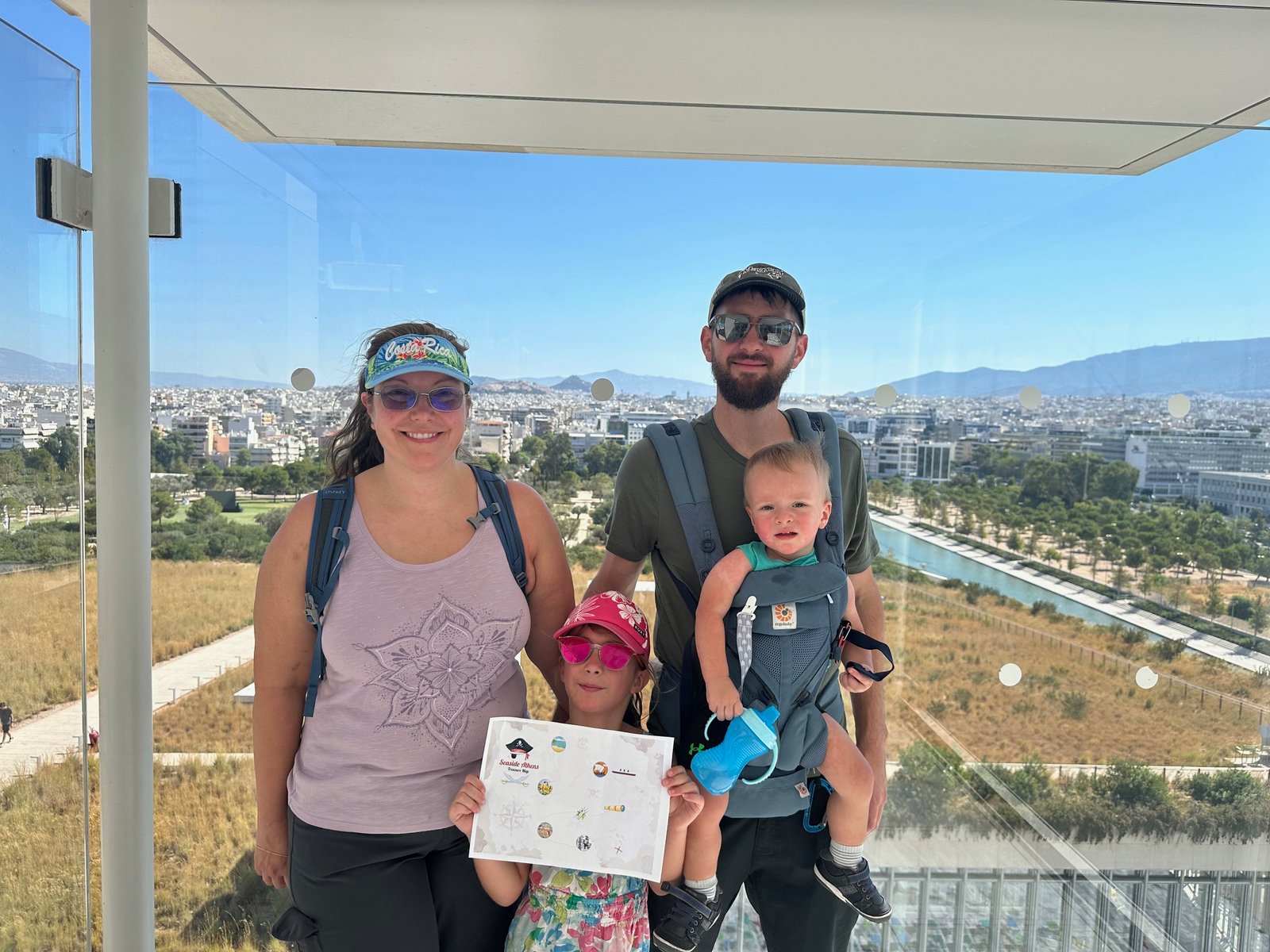 | 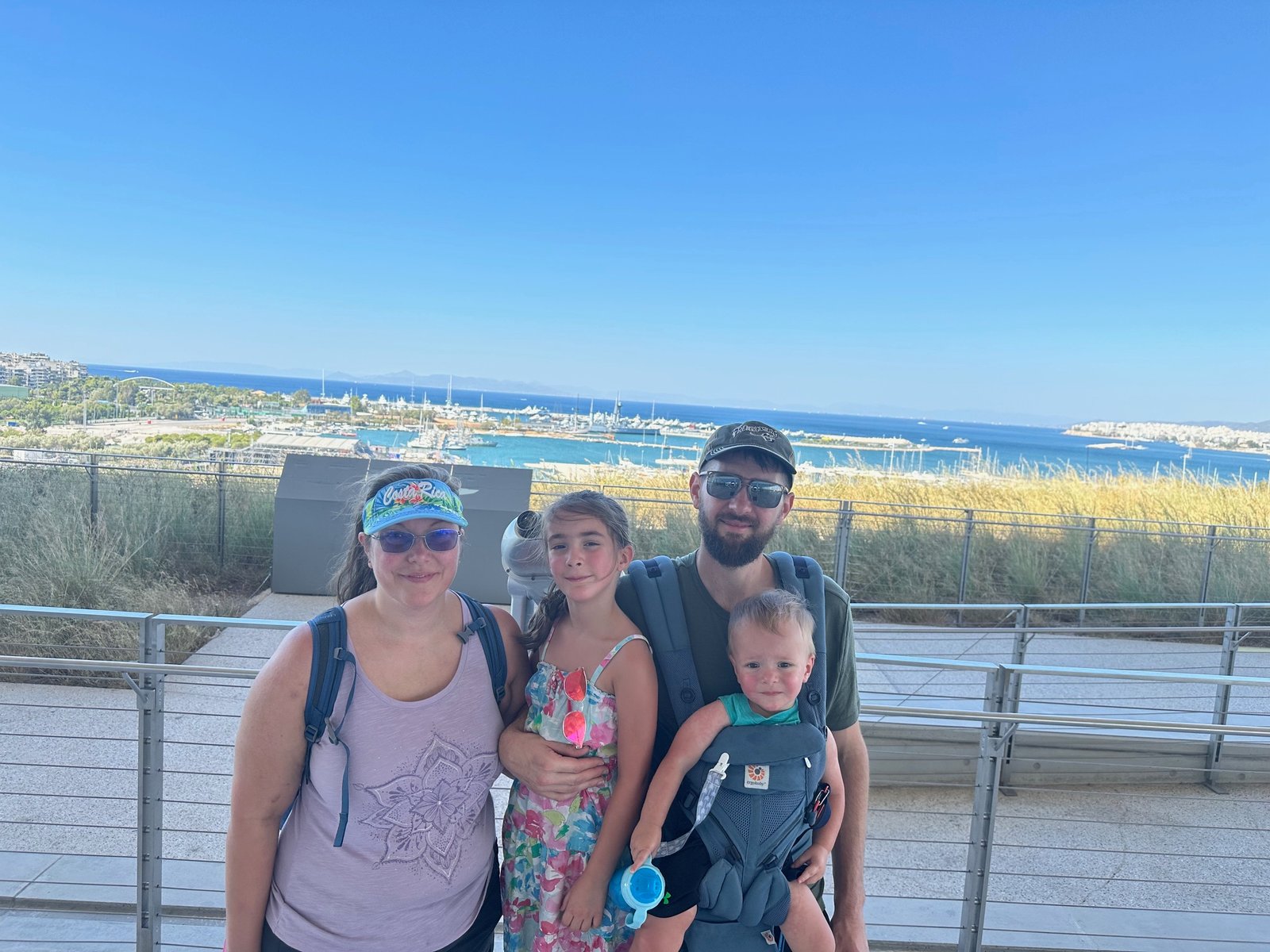 |
A Perfect Tour for Kids
Agathi, our tour guide, was amazing with the kids. As a parent herself, she knew exactly what to do to keep them engaged. She even created a treasure map for our daughter, making the experience interactive and fun.
After soaking in the breathtaking views from the SNFCC rooftop, we headed down to the water park area—a great place for kids to splash around and burn off some energy.

A Cultural Exchange for the Kids
Our kids played for nearly an hour at the water park before we had to move on. They had a great time interacting with Greek children, who seemed just as curious about them. It was fun to watch this little cultural exchange unfold.While the kids played, we spent time chatting with Agathi. She was a fantastic conversationalist, answering all our questions about life in Greece, Athens, and the culture. Her knowledge and insights made the experience even more enjoyable.
A Sweet Ending at the Harbor
After the water park, we walked down to the harbor and enjoyed some gelato by the water. The sea was crystal clear, making for a picture-perfect ending to a wonderful family day in Athens.After the tour, Agathi stayed with us until the hotel transportation arrived, making sure everything went smoothly. I had no idea where to tell them to pick us up, but Agathi handled it all, coordinating directly with the hotel.
Since the only available option was a luxury 12-passenger van, the hotel sent it for the price of a standard cab—a great deal!
If you’re traveling with kids, I highly recommend contacting Agathi for a fun, well-organized, and reasonably priced tour.
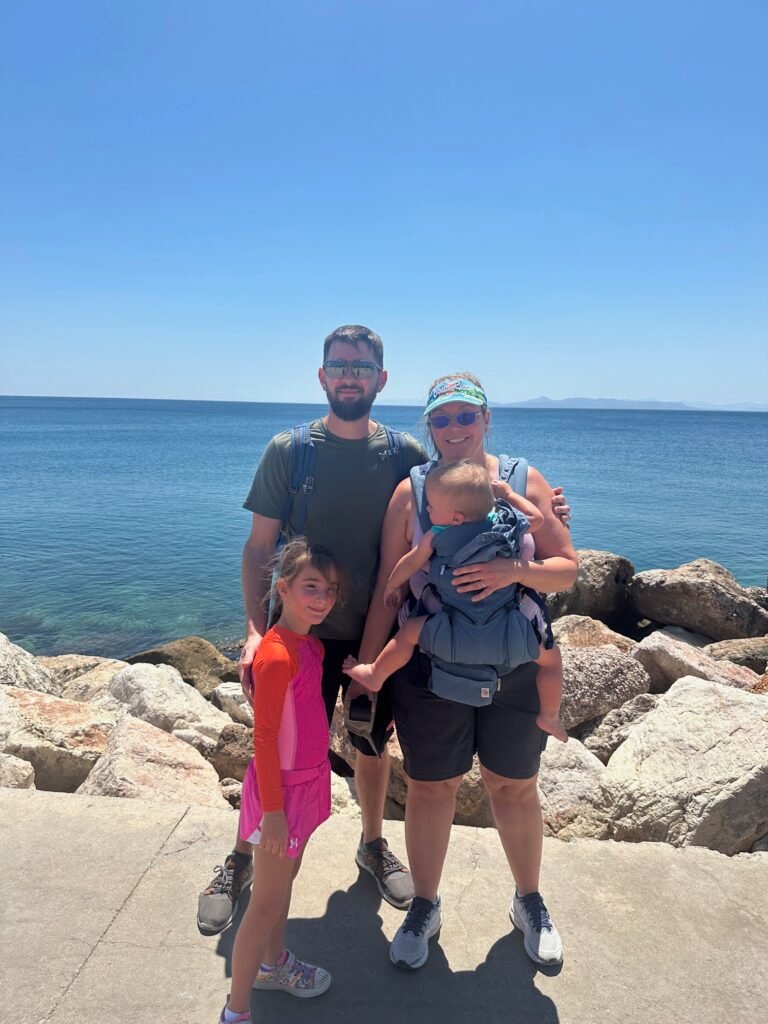
Photoshoot In Athens at the Grand Hyatt
Nasir Javed – Photographer in Athens
The Grand Hyatt was gracious enough to grant our photographer, Nasir Javed (+30 697 408 3743), access to the property for a rooftop photoshoot. I can confidently say that Nasir is honest and talented—a great choice if you’re looking for a photographer in Athens.
I booked him through With Locals (WL), and though he has 10+ years of experience, I was his first booking on WL. He had mistakenly entered his pricing incorrectly—WL adjusts the cost based on party size, but his price remained the same whether for one or four people.
When I inquired about adding an extra hour, he immediately acknowledged the pricing mistake but still honored my booking. He offered to create a custom package, but I decided to stay with one hour. This level of honesty and professionalism stood out—I’ve had a similar situation happen before in Rome, but that host canceled instead of honoring the booking.
Nasir did not cancel and likely wouldn’t have even mentioned the error had I not asked about extra time. If you need a reliable and skilled photographer in Athens, I highly recommend him.
Photo Collage of our Favorite Photos from the Shoot.

Photo Collage of our favorite photos from the shoot.
Athens to Hydra: A Journey to a Car-Free Island
To get to Hydra, we had the hotel arrange a cab with car seats to take us to the ferry. Since they couldn’t get a yellow cab, they provided a private luxury car at no extra charge—a black Mercedes or similar luxury vehicle, with a driver in a suit who is certified in English proficiency.
The driver dropped us off less than 100 yards from the ferry terminal in Piraeus, the port of Athens.
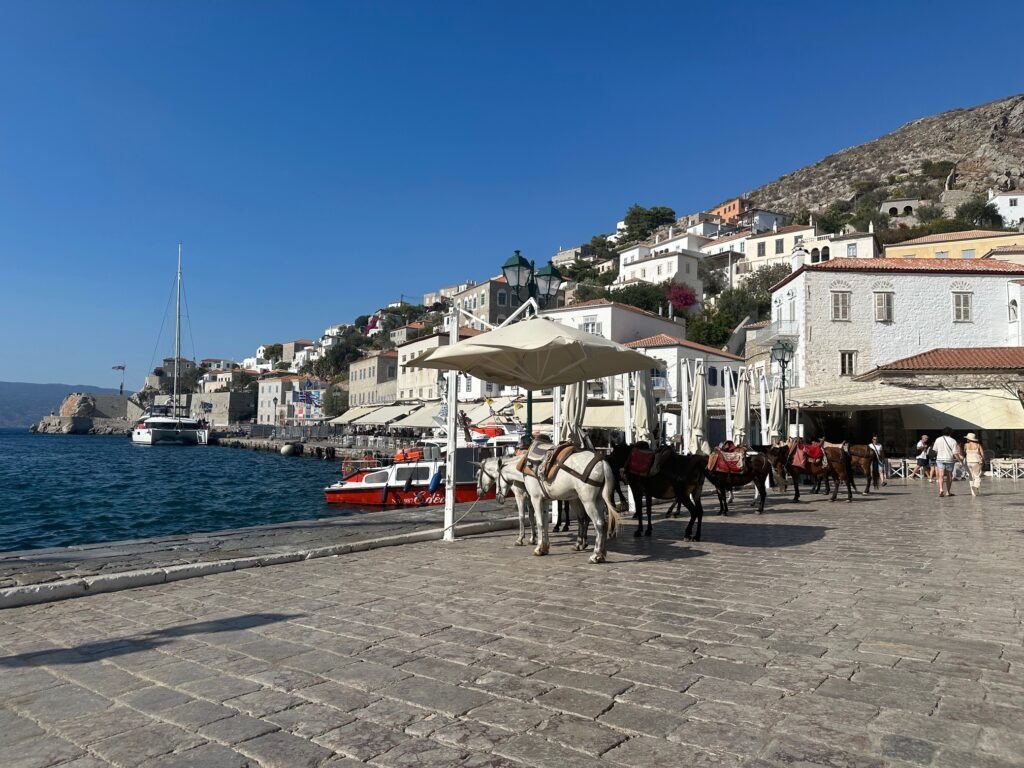
Ferry Ride to Hydra
The ferry ride to Hydra takes 1.5 hours. First-class tickets for all four of us cost $200 round trip. Children under 4 ride free and kids aged 4-10 get 50% off. I highly recommend Ferry Hopper—it’s easy to book and cancel online. We used them for all our ferry rides and even canceled a Poros ferry with no issues.Some ferries are faster, and I could have saved $50 with a different company, but it would have added 30 minutes each way. For me, the time savings was worth the extra cost.
Arriving at Hydra
Nothing compares to Hydra. From the concrete jungle of Hong Kong to the rainforests of Costa Rica to the architectural wonders of Gaudí in Spain, Hydra has the most unique feel of any place I’ve ever visited.
The island has no cars, except for limited public service vehicles (mainly fire trucks and garbage trucks).
If you’re visiting Hydra, pack light!
Since no cars are allowed, donkeys and pack mules are used for luggage transportation. If you’re only visiting for the day, skip the extra weight and start walking along the waterfront as soon as you step off the boat.
We took the road west and walked to the next marina, enjoying the scenic views and charm of this one-of-a-kind island.
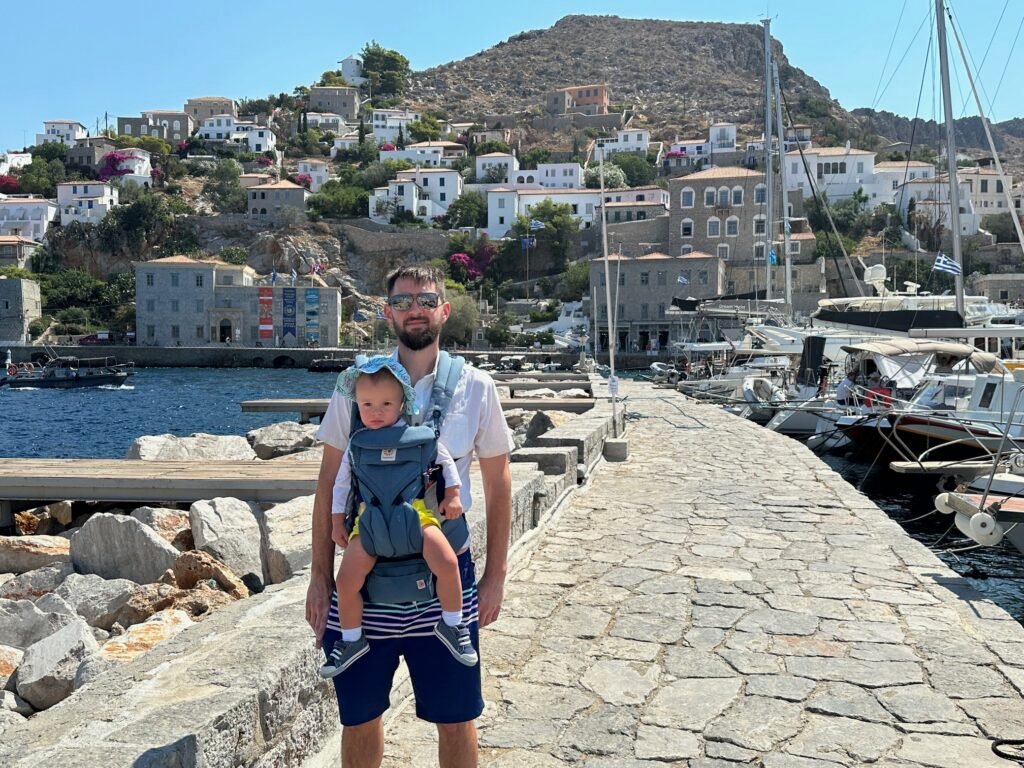
All construction material was carried uphill to build these homes
Our first stop was Spillia Beach Bar for Limoncello and sparkling water.
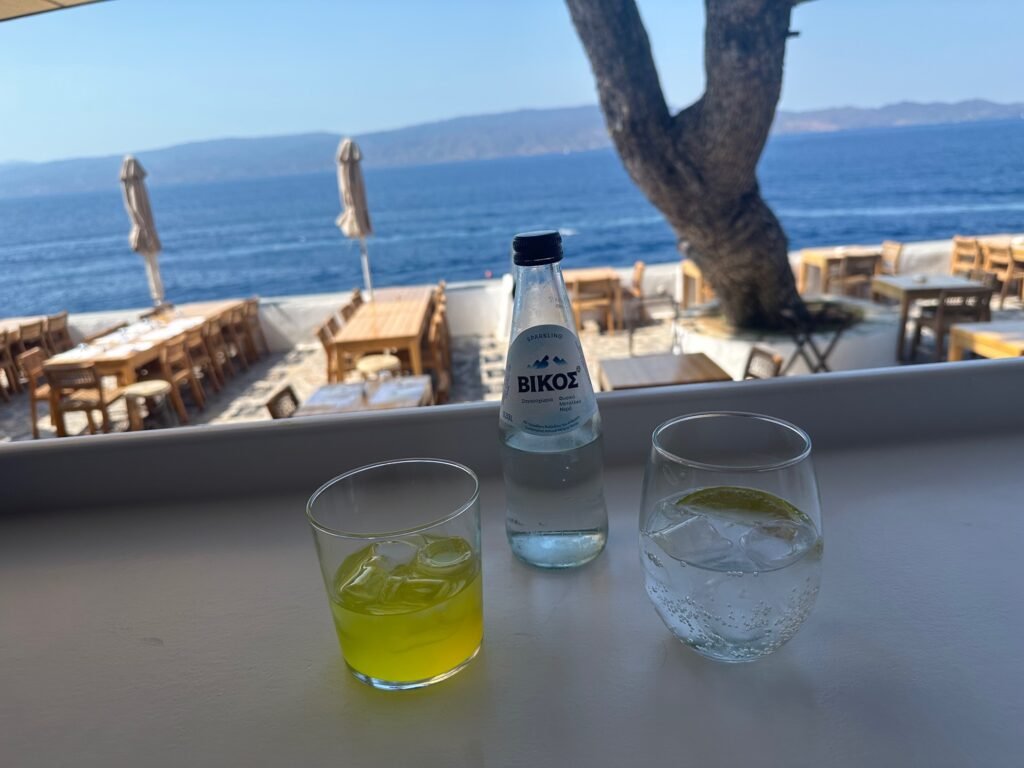
As we continued west along the coast, we discovered multiple swimming spots and beaches. However, entry and exit were not child-friendly, so we skipped most of them.
Avlaki Beach
The best place we found for the kids was Avlaki Beach—a quiet, scenic cove with gentle waters.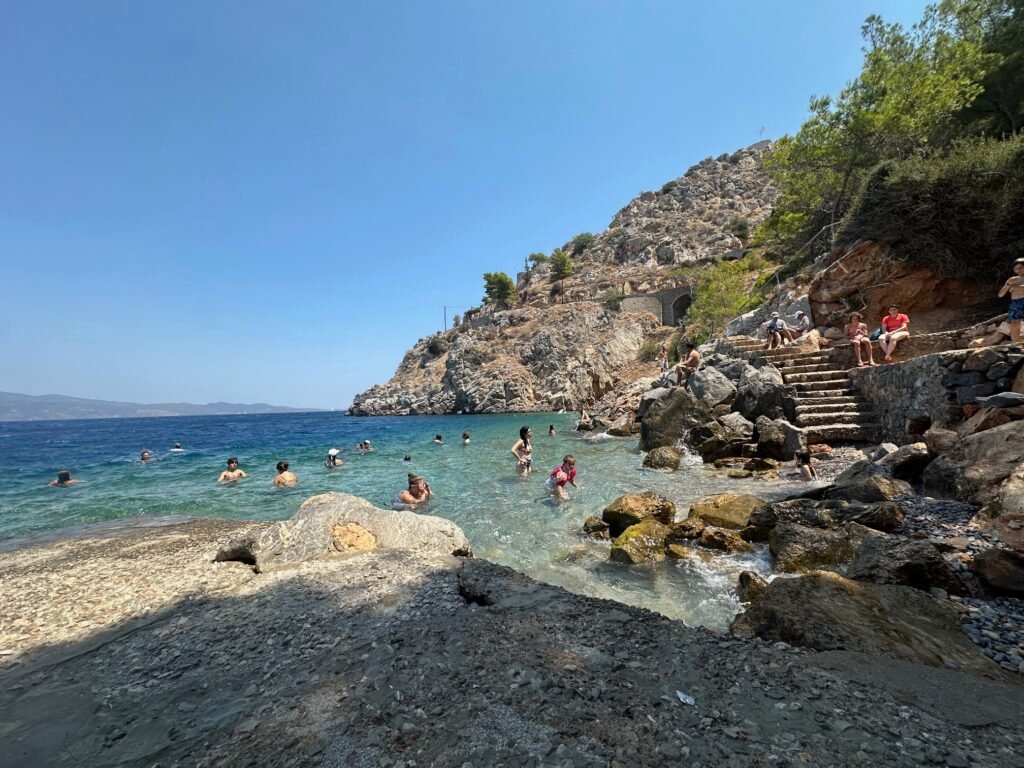
Avlaki Beach
Avlaki was the perfect spot to let them splash and play, but my daughter was not a fan of the saltiness. In her defense, the Mediterranean is 1.5 times as saline as the Atlantic, making it a stark contrast for anyone used to milder ocean water.
Despite that, the beach itself was peaceful and picturesque, offering a beautiful introduction to Hydra’s untouched natural beauty.
Why does the Mediterranean have a higher salinity?
The Mediterranean has a high rate of evaporation. The water evaporates leaving the salt behind. This is compounded by limited water exchange. The only connection the Mediterranean has to the Atlantic is the Strait of Gibraltar. This narrow path limits the exchange of water between the oceans that would lower the salinity from the water mixing.
A Meal to Remember at Kodylenias Resto
Since we were in Hydra, I thought it was only fitting to splurge on a fresh seafood meal. After all, the fish had been caught that very morning.We walked down to Kodylenias Resto, and I can honestly say that this was the best fish I have ever eaten. It was so good that I’d return to Hydra just to eat here again.
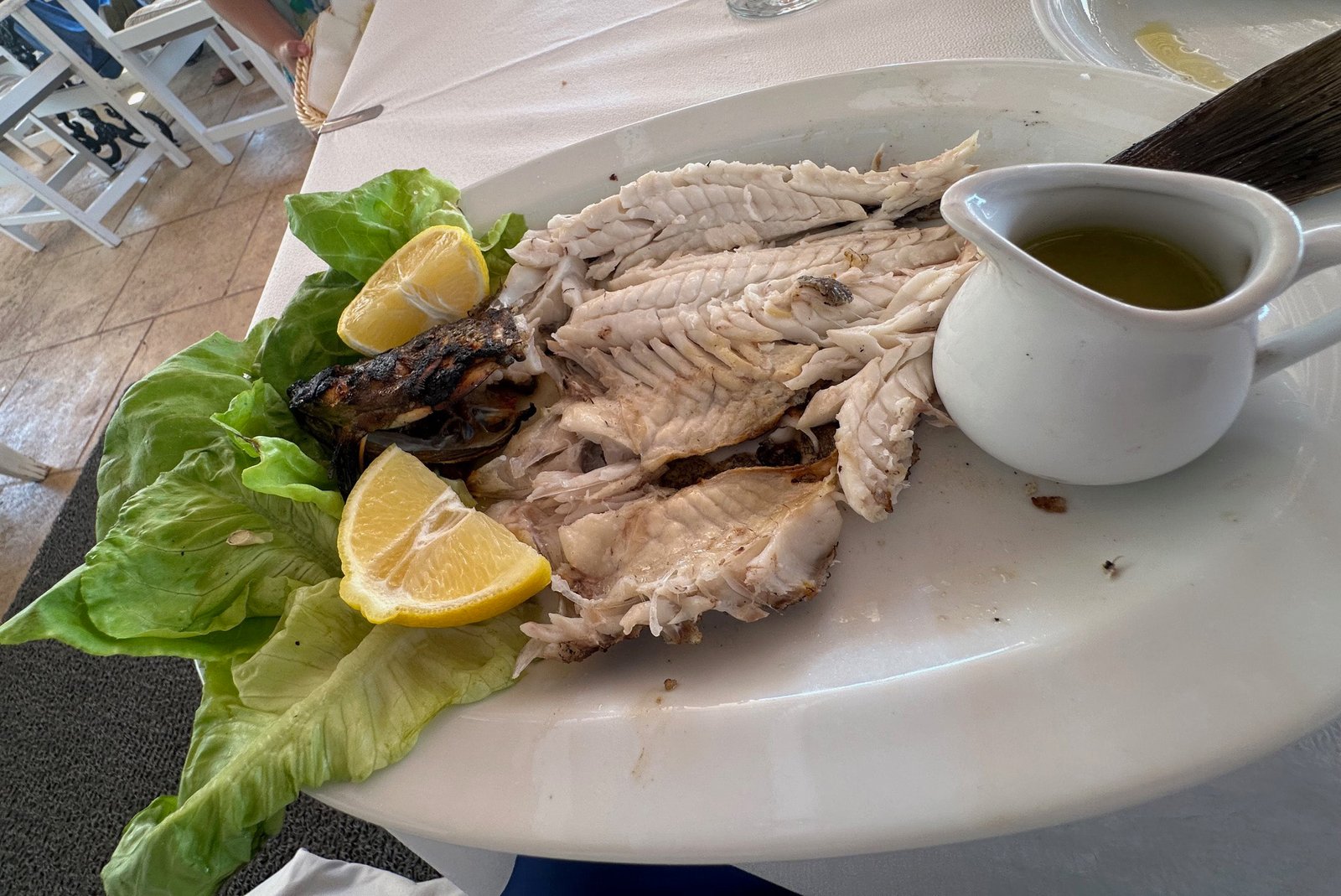
With drinks, kids’ meals, and a vegetarian option, our total bill came to around 100€—a fantastic value for such an incredible meal.
By the time we finished lunch, it was 3 P.M., and we needed to start walking back to the main dock to catch our return ferry.
A Peaceful Walk & Return to Athens
Walking around without the noise of cars made Hydra feel like a true escape. The tranquility and charm of the island left a lasting impression, and after this visit, I definitely want to explore more of the Greek Isles.The walk back to the dock was uneventful but filled with stunning coastal views. The ferry back was the same one we had taken earlier, making for a smooth return.
When we arrived in Athens, our hotel had a driver with two car seats waiting. The hotel’s transportation service was excellent—not much more expensive than booking it myself, and when you factor in the points earned from charging it to the room, I probably came out ahead.
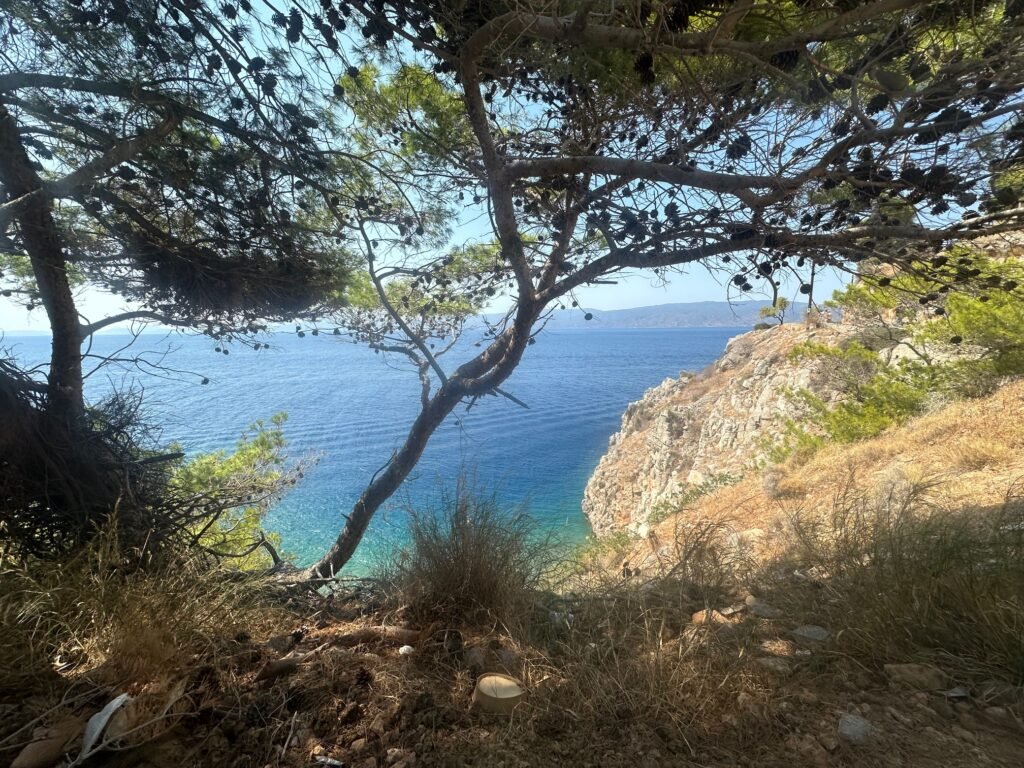
Acropolis Private Tour with Costas
For 9 A.M. to 4 P.M., we booked a private Acropolis and Acropolis Museum tour with Costas (+30 693 769 6500) through With Locals. At around $500, this was an absolute bargain.
We did six tours total on this trip, and without a doubt, this was the most informative and my favorite. Costas was an incredible guide, bringing history to life with his deep knowledge of Greek mythology and ancient history, combined with a natural storytelling ability.
He took the time to understand our interests and expanded on them, ensuring everyone was engaged. His passion for history was evident, making the experience truly unforgettable.
Costas has an impressive academic background, including expertise in law, linguistics, philology, history, archaeology, and book translations—all of which contributed to the depth of knowledge he shared with us.
We met at Queen Gelato Athens before heading to the Acropolis.
Acropolis with a Guide: A Must-Do
Hiring a private guide is absolutely worth it. There’s so much history you simply wouldn’t know without one, and a great guide like Costas brings the site to life.
This time, we entered through the side entrance near the Dionysus Theater. I preferred this entrance over the main gate because:
- Shorter lines
- No protesters
- A more enjoyable walk up
This might have been partly because Costas was explaining everything along the way, making every step fascinating.
Statue of Dionysus: God of Wine & Theater
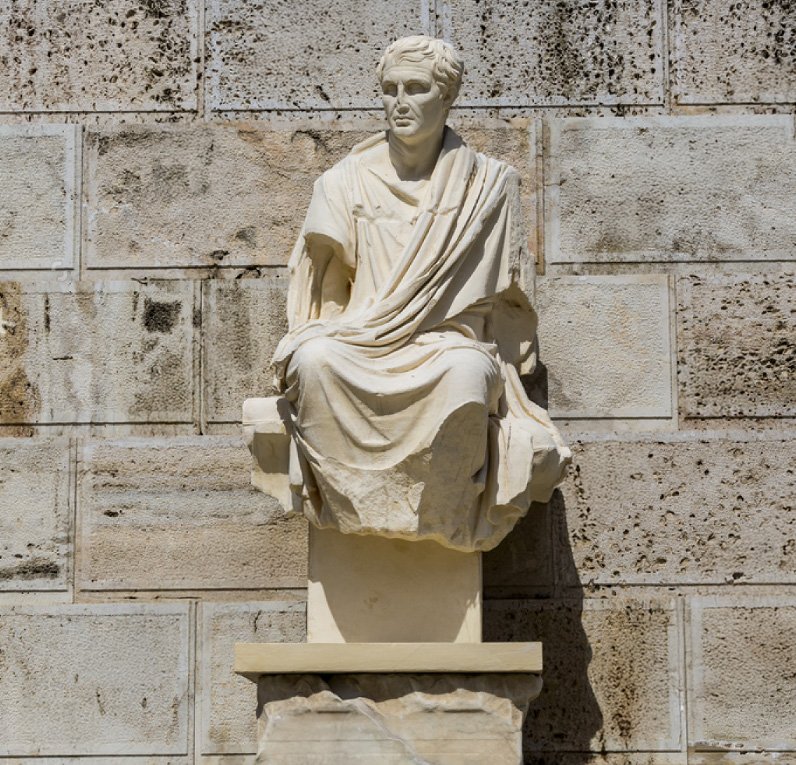
The first stop was the statue of Dionysus. Here sat Dionysus, the god of wine, revelry, and theater, overlooking the place where Athenians once gathered to celebrate him with grand performances.
According to legend, Dionysus traveled the world spreading the gift of wine, bringing both joy and madness to those who embraced it. But he was more than just a god of indulgence—he represented transformation, much like the theater itself, where actors stepped into different lives.
Standing in front of this statue, I could almost hear the echoes of ancient voices, laughter, and applause, honoring the god who blurred the lines between myth and reality.
Theatre of Dionysus: The Birthplace of Drama
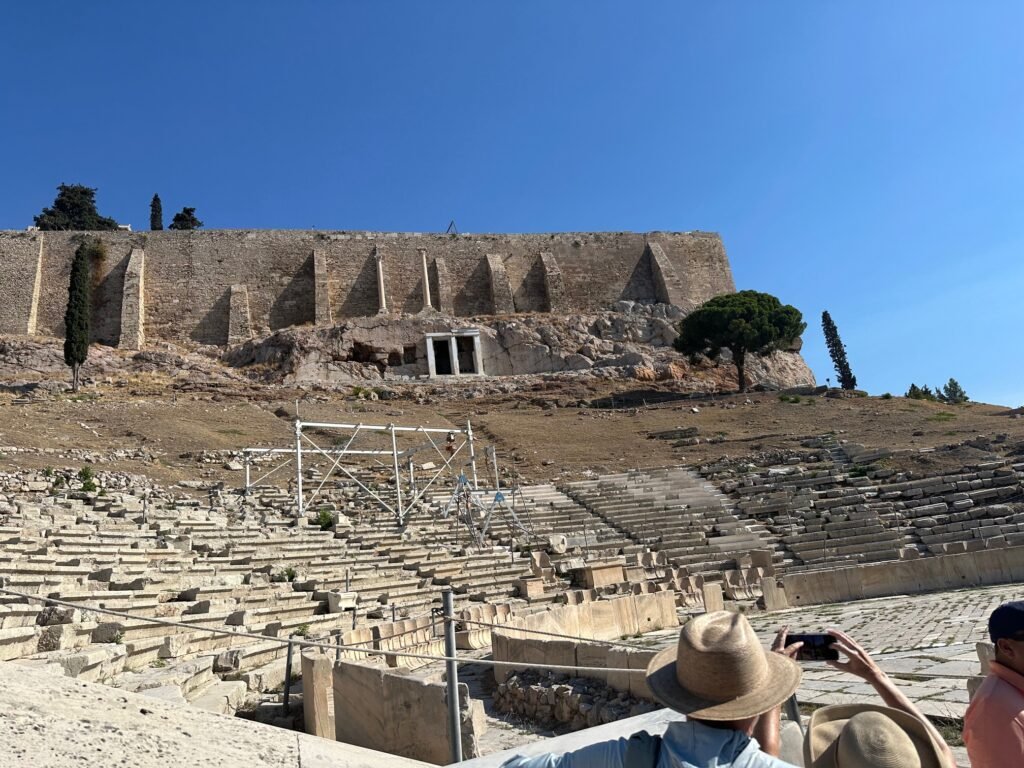
The Theater of Dionysus is where Greek drama was born. Imagine ancient Athenians filling these seats, eagerly awaiting tragedies and comedies performed in honor of Dionysus, the god of wine and revelry.
It was here that legendary playwrights like Sophocles, Euripides, and Aeschylus debuted their masterpieces, forever transforming the art of storytelling. Dionysus, the god of transformation, still seems to linger in this space, where actors once blurred the line between reality and myth.
Odeon of Herodes Atticus: A Timeless Stage
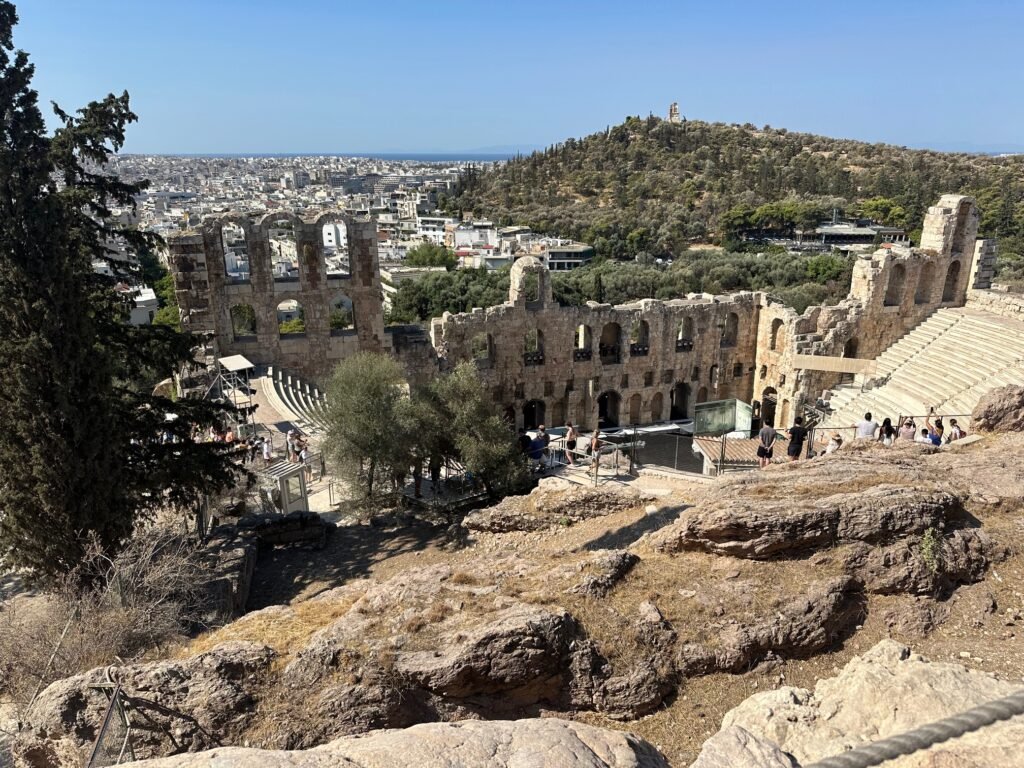
Nestled beneath the Acropolis, the Odeon of Herodes Atticus has been a grand stage for performances since the 2nd century AD. Built by Herodes Atticus in memory of his wife, this theater once echoed with the sounds of music, poetry, and drama.
Unlike the Theater of Dionysus, which was dedicated to revelry, the Odeon represented a more refined artistic space, where Roman-era Athens embraced culture at its finest. Even today, as the sun sets over the Acropolis, modern audiences still gather here for performances, continuing a nearly two-millennia-old tradition of storytelling.
The Pandroseion Temple: A Mythological Landmark
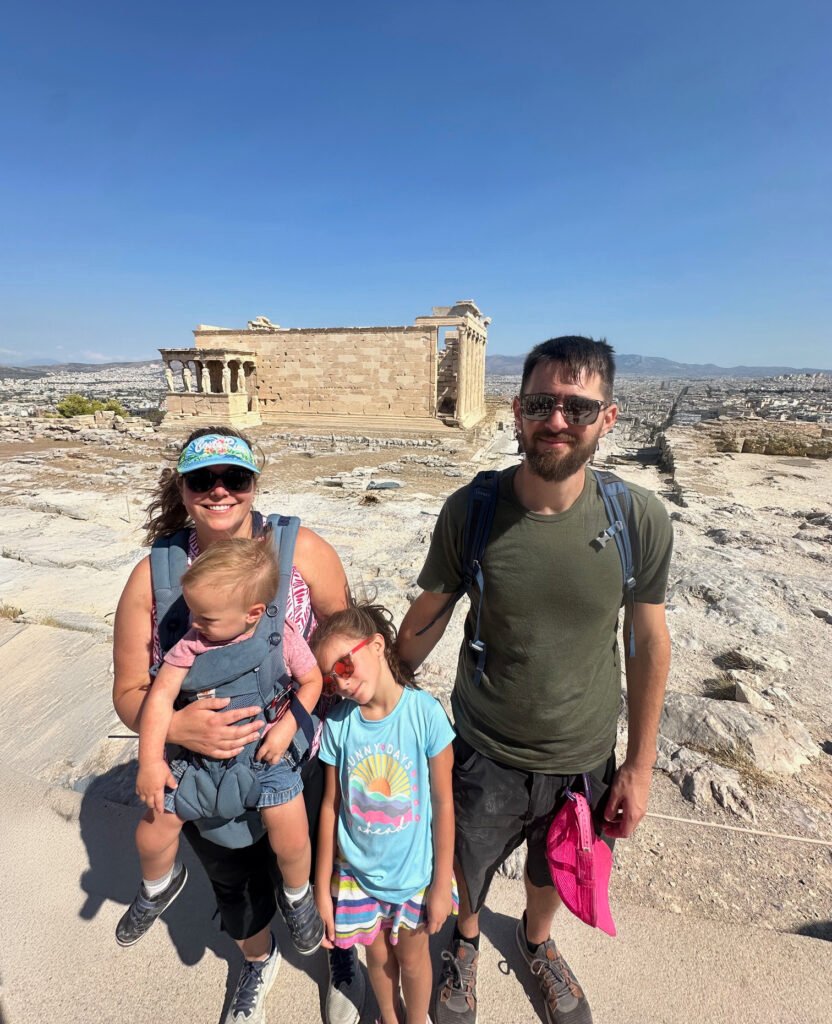
The Temple of Pandroseion is dedicated to Pandrosos, daughter of King Cecrops. This temple is deeply tied to the famous myth of the contest between Athena and Poseidon for the patronage of Athens.
- Athena’s Gift: She offered the city a sacred olive tree, symbolizing peace and prosperity.
- Poseidon’s Gift: He struck the ground with his trident, bringing forth a saltwater spring.
The Verdict: Though Poseidon’s gift was powerful, the water was brackish. The olive tree was deemed more valuable, and Athena became the city’s protector.
The Temple of Pandroseion stands in honor of this mythical moment, marking the spot where Athena’s sacred olive tree was believed to have been planted
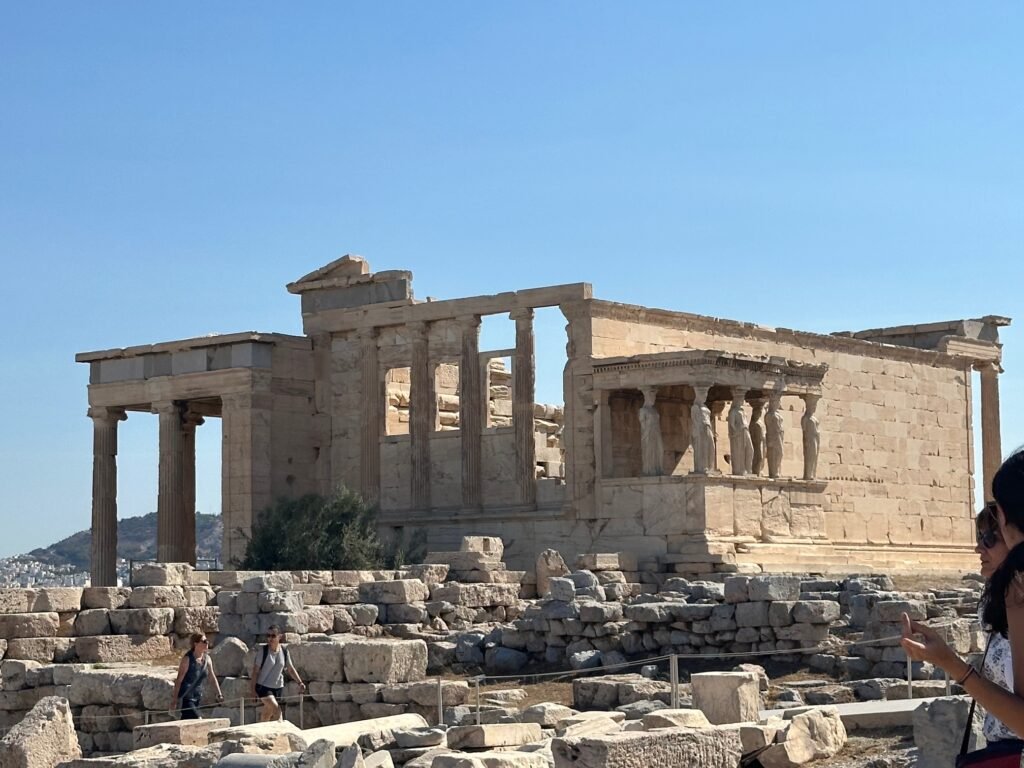
Temple of Pandroseion
The Parthenon
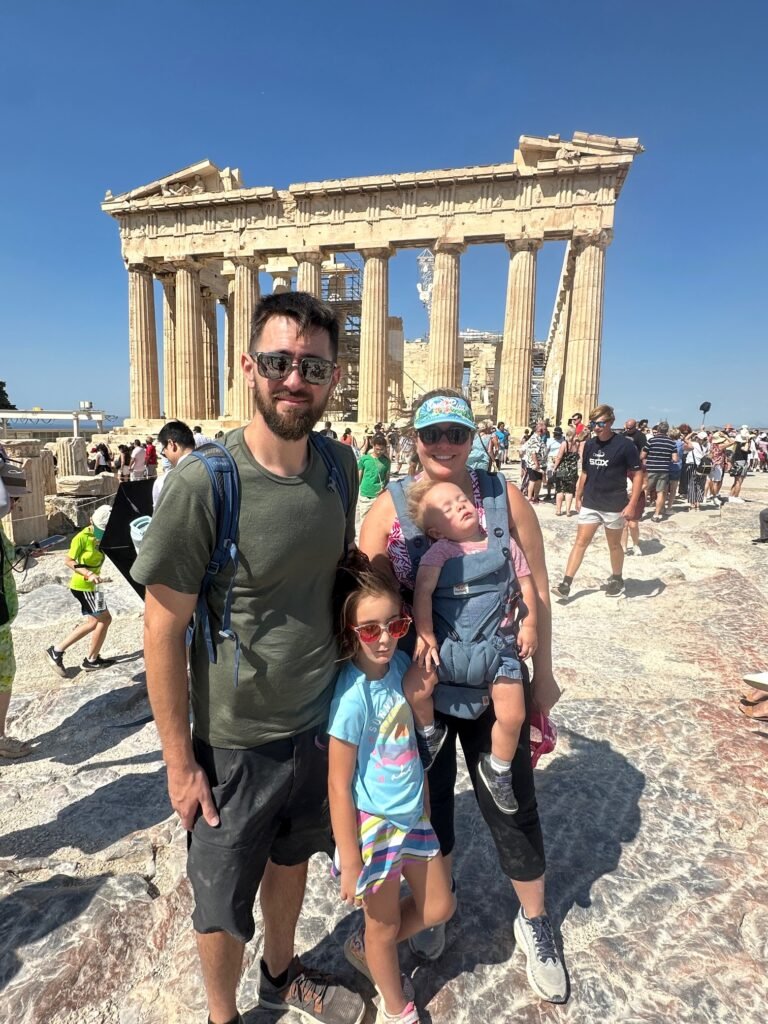
The Parthenon, constructed in the 5th century BC, stands as a symbol of ancient Greece’s power, artistry, and devotion to their gods. Built at the height of the Athenian Empire, it was dedicated to Athena, the goddess of wisdom and the city’s protector.
Over the centuries, the Parthenon has transformed—serving as a temple, a Christian church, and even a mosque. 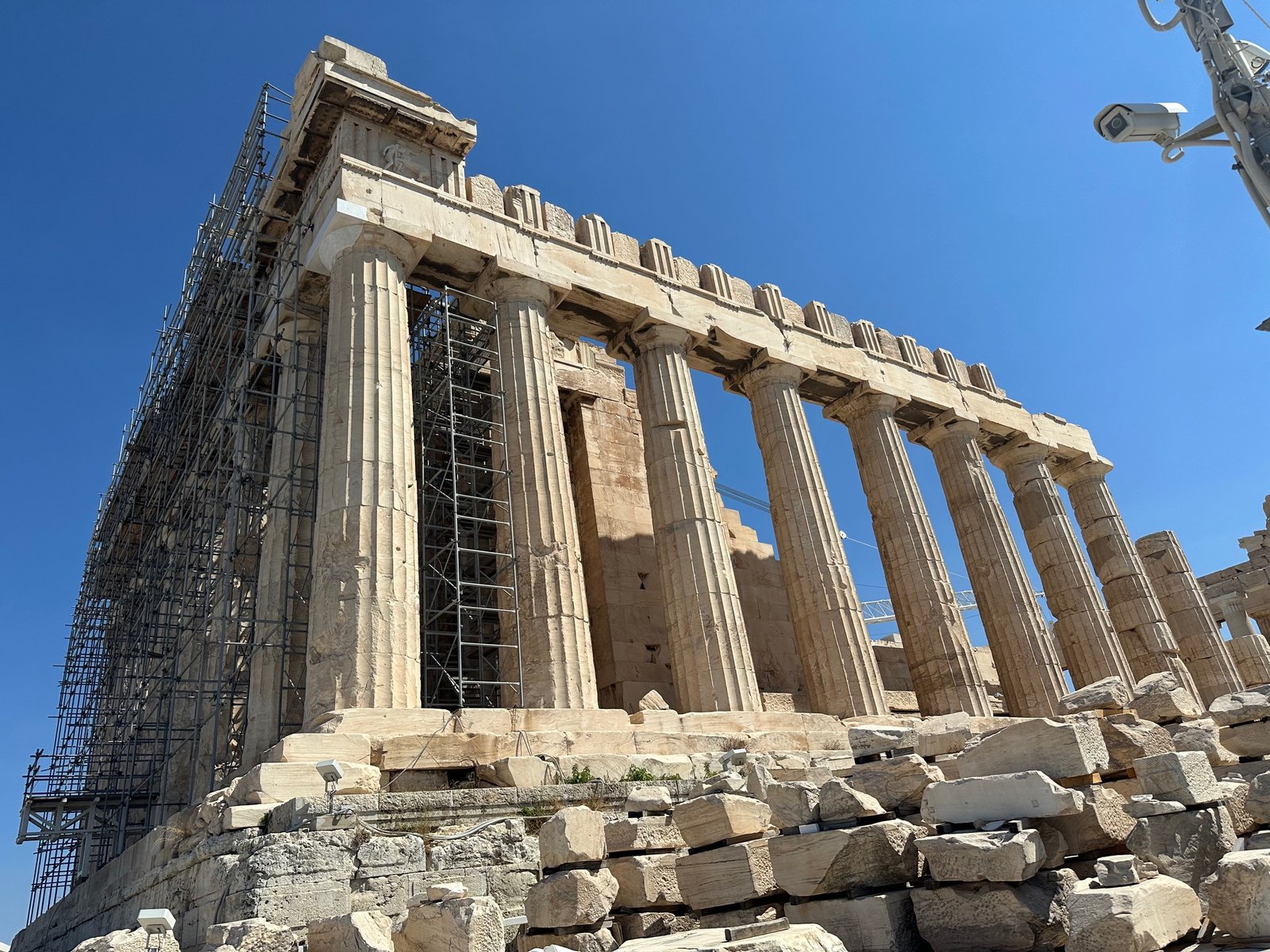
Architectural Genius: The Use of Entasis
Costas explained that the ancient Greeks used a technique called entasis, where the columns are slightly curved outward and the horizontal lines of the temple, like the stylobate (base), are subtly convex rather than straight.
This was done to counteract the optical illusion that straight lines appear to sag or bend in the middle due to how the human eye perceives them. The Parthenon’s gentle curves were a brilliant solution that created the illusion of perfect straightness and balance when viewed from a distance.
By this point, the kids were getting tired, but we still had three hours left on the tour. Costas, being the expert guide he is, knew exactly what to do—he took us to a restaurant near the Acropolis Museum for a well-deserved break before we continued our exploration.
A Meal & Conversation at Athina Restaurant
After the tour, we dined at Athina Restaurant, where I decided to have fish again. While it was good, it didn’t quite compare to the fish in Hydra. That said, all the food was excellent.
During the meal, I had a fascinating conversation with Costas about various aspects of Greek life. I’m always curious about how things work in different countries, so we covered electricity service, local politics, waste disposal, emergency services, and much more.
Costas even followed up later that evening to answer a technical question about how electricity billing works in Greece. He sent me a detailed breakdown of his own electricity bill, ensuring my question was fully answered—just another testament to his depth of knowledge and generosity.
Exploring the Acropolis Museum
Stepping into the Acropolis Museum, we were greeted by a strikingly modern design that contrasts beautifully with the ancient artifacts on display. The ground floor featured items from ancient Athens, primarily sculptures and pottery, each with detailed descriptions explaining their significance.
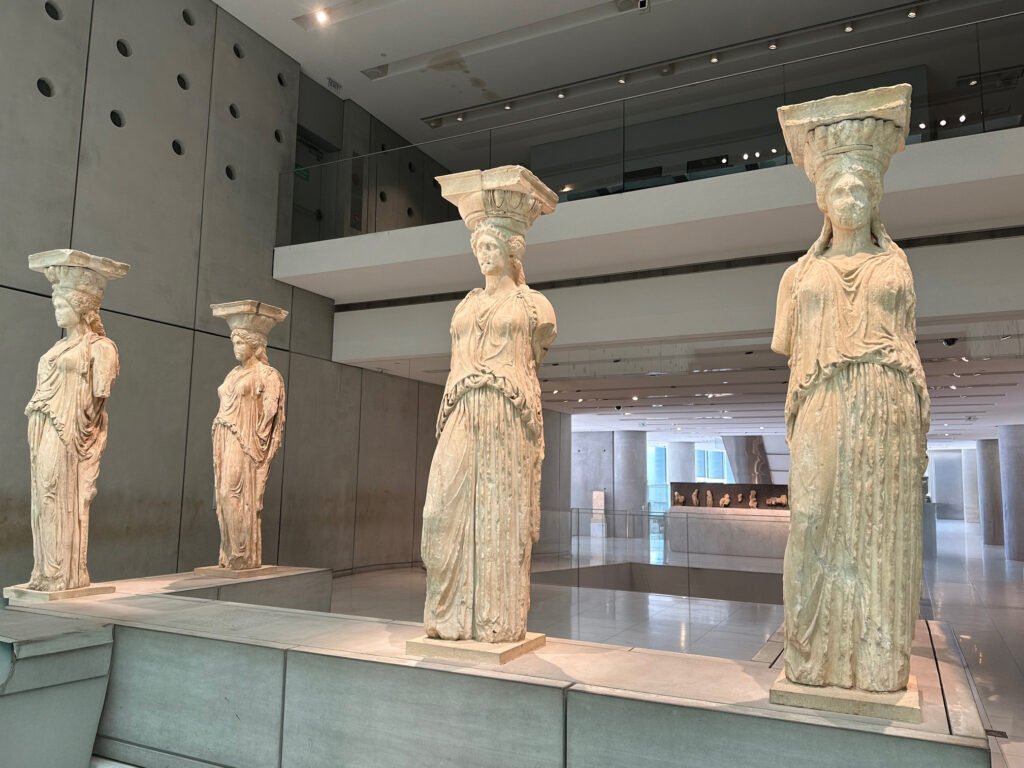
The Caryatids – they once supported the roof of the Erechtheion Temple.
As we moved up to the second floor, we reached the Parthenon Gallery, home to the iconic Parthenon Marbles. The gallery was designed to mirror the proportions of the Parthenon itself, allowing visitors to see the sculptures as they were originally intended to be displayed. Each piece tells a story from Greek mythology, capturing the golden age of Athens through breathtaking artistic mastery.
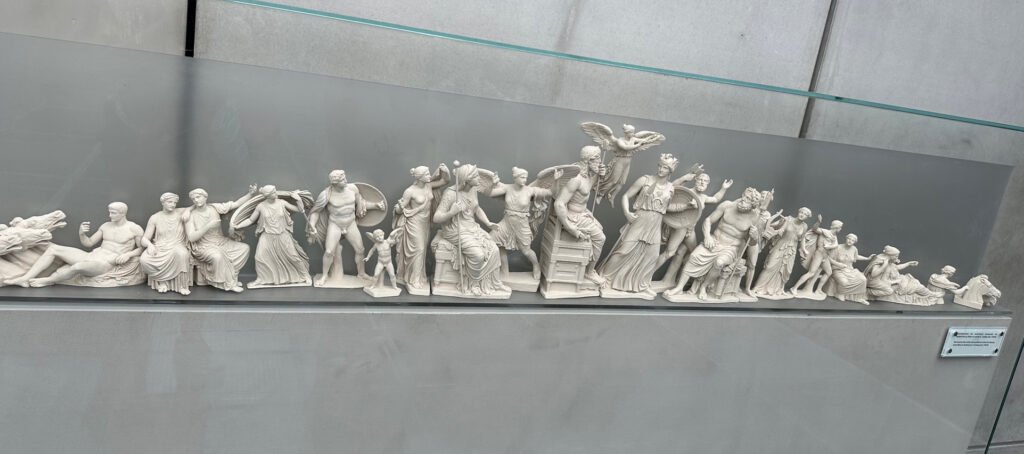
Reproduction of the Parthenon frieze, a magnificent set of sculptures that once adorned the upper part of the Parthenon
On the top floor, expansive windows provide a stunning view of the Acropolis, reinforcing the deep connection between the artifacts and the ancient site itself. This floor dives even deeper into the history of the Parthenon, explaining its architecture and cultural importance in greater detail.
It’s clear that the Acropolis Museum isn’t just a place to display artifacts—it’s a space where the history of Athens is brought to life.
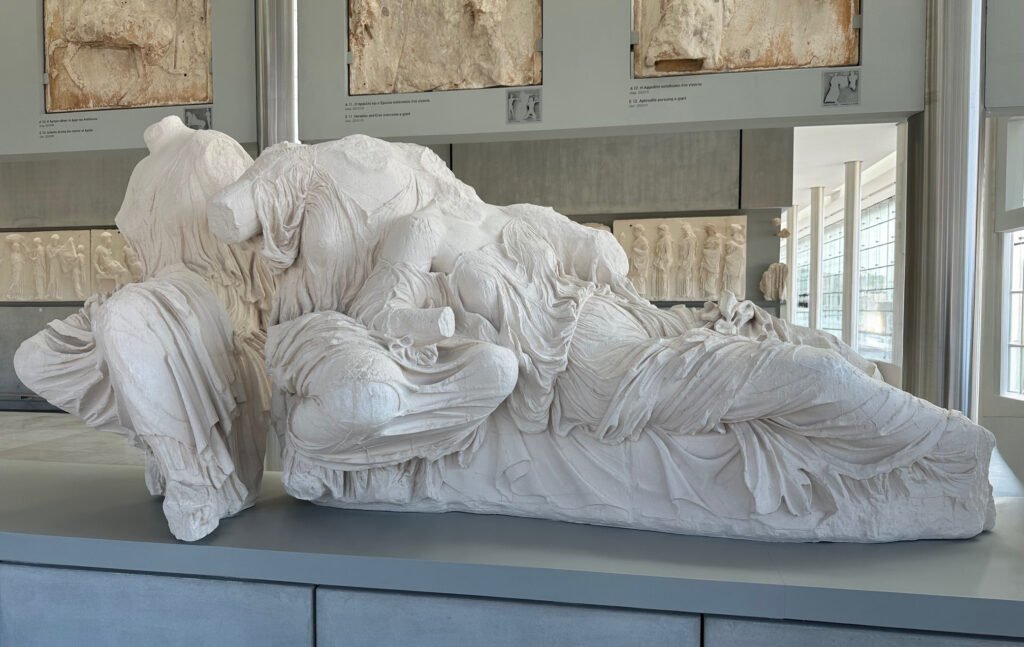
Costas kept us engaged the entire time, seamlessly weaving together mythology, history, and archaeology in a way that made every exhibit fascinating. His thorough explanations and ability to answer every question made the experience truly exceptional.
As we exited the museum, there was one final surprise—glass floors beneath our feet revealed the ruins of an ancient Athenian neighborhood, offering an incredible final glimpse into life in ancient Greece before we stepped back into the modern world.
Kids Park near the Grand Hyatt Athens
After a long tour the day before, we decided to take it easy, spend some time at the hotel, pack, and then visit a nearby park.
The park, called Θρίαμβος Αθηνών, is less than a 10-minute walk from the Hyatt. While small, it had plenty to keep the kids entertained, including a playset, swings, a jump pad, and a teeter-totter. It was a great place for them to burn off energy before our flight.
 | 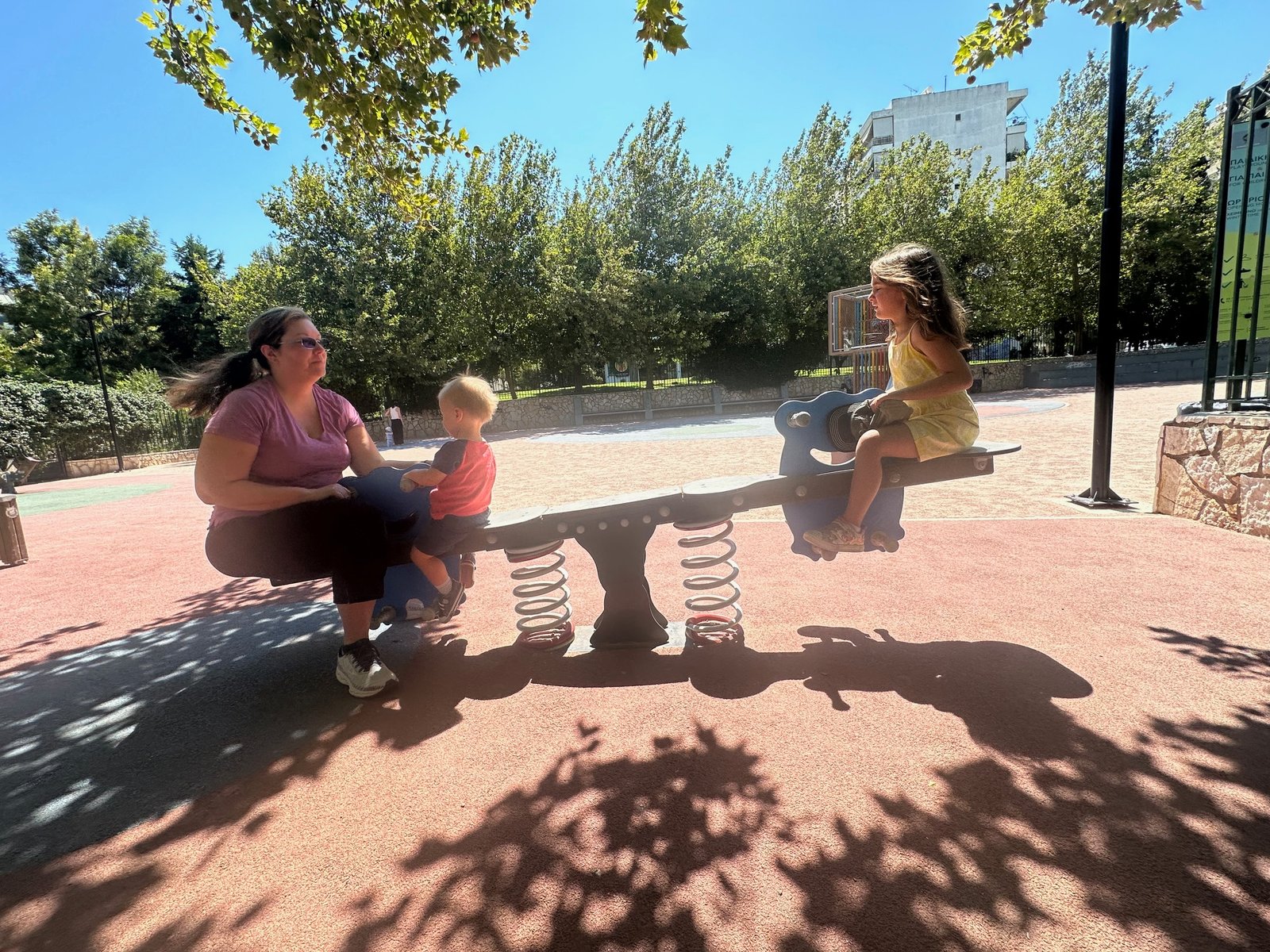 |
Our flight was scheduled for 4:15 PM, and we were able to get late checkout at 1 PM—giving us time to relax before heading to the airport.
We flew with Eurowings, and unfortunately, the experience was horrible.
Departure & The Eurowings Experience
We arrived at the airport 2 hours early to avoid any issues, since we were flying economy on a budget airline. The tickets for all four of us, including baggage, was $489.
Unfortunately, Eurowings does not open its ticket counter until 60-90 minutes before the flight. With the long line, I doubt we could have checked our bags and cleared security if we had arrived 30 minutes later.
To make matters worse, Eurowings had no signs, so we had to ask the airport information desk where to queue. They sent us to the wrong counter—a ticket sales desk. The associate there looked up the correct check-in counter, which, of course, was on the other side of the airport.
The flight was 45 minutes late, which, for European budget airlines, wasn’t terrible.
Next Stop: Spain, Germany, and France!
In spite of the delays and miscommunication, we were able to catch our flight to our next destination. With Greece behind us, we were ready for the next leg of our adventure—Spain, Germany, and France!



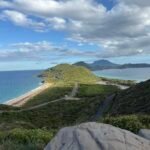










I like this website very much so much great info .